PRESTO PLANS
Sent straight to your inbox
CLICK HERE TO ACCESS
Sign up to receive 10 ready-to-use ELA resources your students will love!
10 FREE ELA RESOURCES
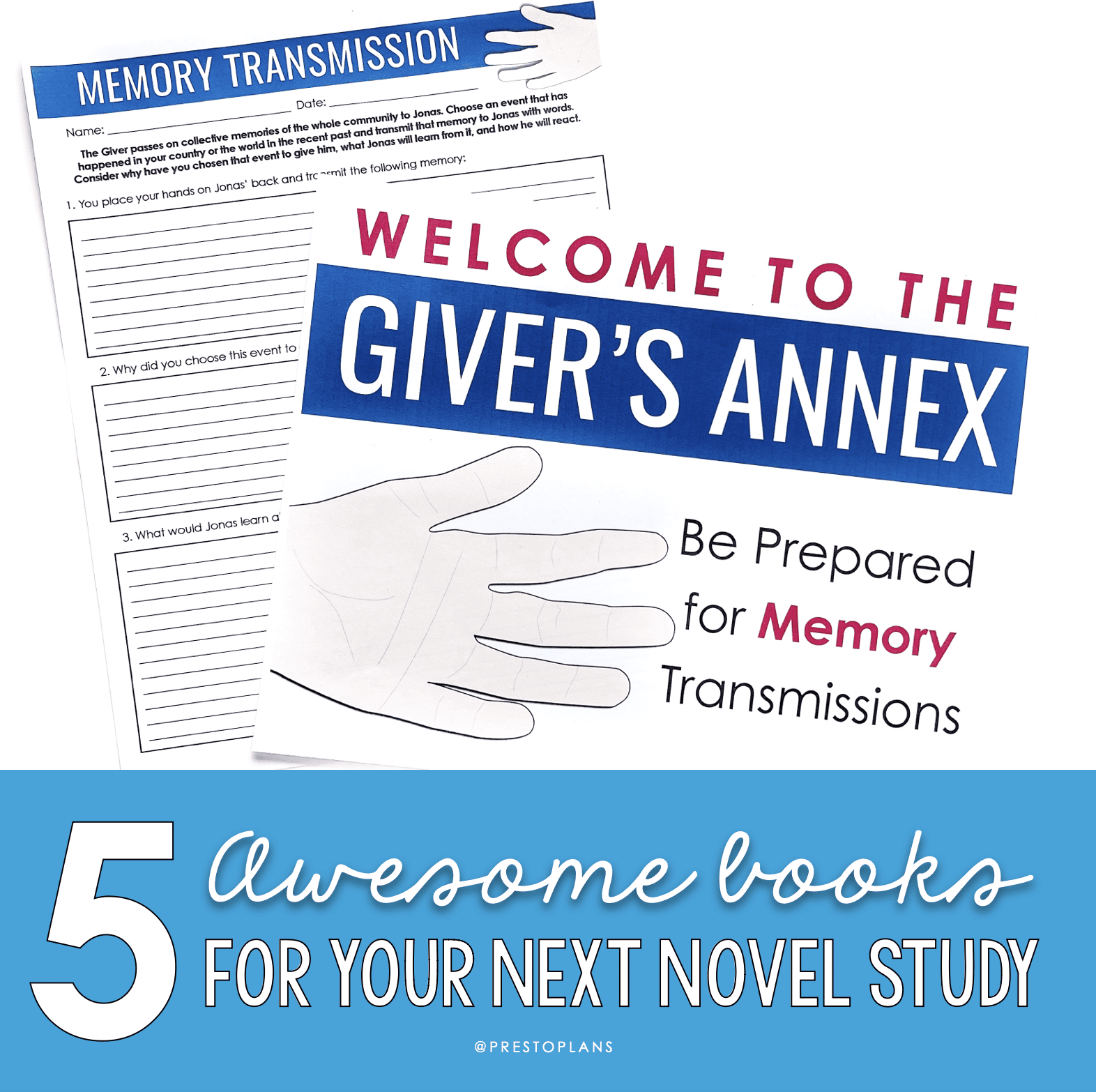
5 Awesome Books for Your Next Middle School Novel Study
In my experience, there are two groups of ELA teachers in the world: those who love middle school novel study units, and those who don’t! Novel studies can be incredibly powerful tools in middle school ELA. They create a shared culture and common language around a specific text, and students can explore themes and connections that take them far beyond the walls of their classroom. But I can also see where the middle school novel study critics are coming from. After all, a “bad fit” middle school novel study isn’t fun for anyone – students and teacher alike!
Through experience, I’ve learned that there are some books that lend themselves more naturally to middle school ELA classrooms than others. With this in mind, I’ve narrowed down five awesome novels that are a guaranteed hit with some of the toughest crowds around – middle school students! Here are my five top books to consider for a middle school novel study unit (and some creative activities to pair with them!).
1. Refugee by Alan Gratz
Refugee by Alan Gratz is one of my very favorite texts to explore with middle school readers. This powerful novel is packed with insights into the historical and modern experiences of refugees. It can help students develop a stronger sense of empathy, connection, and global citizenship.
Refugee’s unique narrative structure weaves three separate first-person accounts of refugee children into a rich, interconnected story. Josef is a young Jewish boy living in Nazi Germany in the 1930s, while Isabel is a Cuban girl escaping to Miami during the 1994 rafter crisis. Finally, Mahmoud is a Syrian boy fleeing the Syrian Civil War with his family in 2015. Although all three children are fictional characters, their tales are based on true stories.
Incorporating Nonfiction
Because Refugee requires students to have extensive background knowledge of Germany in the 1930s, Cuba in the 1990s, and the more recent Syrian Civil War, I like to spend some time helping students explore the historical significance of these three time periods.
One way to do this is through a historical timeline assignment. Working individually or in small groups, students read nonfiction articles about the important historical moments leading up to Kristallnacht in Josef’s narrative, the Malenconazo protest in Cuba in Isabel’s narrative, and the Aleppo bombings in Mahmoud’s narrative. Then, they apply their summarization skills as they identify and describe the four major events that led to these moments in history.
This activity works well as a “peer teach,” in which groups of students share their learning with each other as they set the stage for reading. You might even like to turn the end result into an engaging bulletin board display, which can help students connect real historical moments to the experiences of the characters in Refugee.
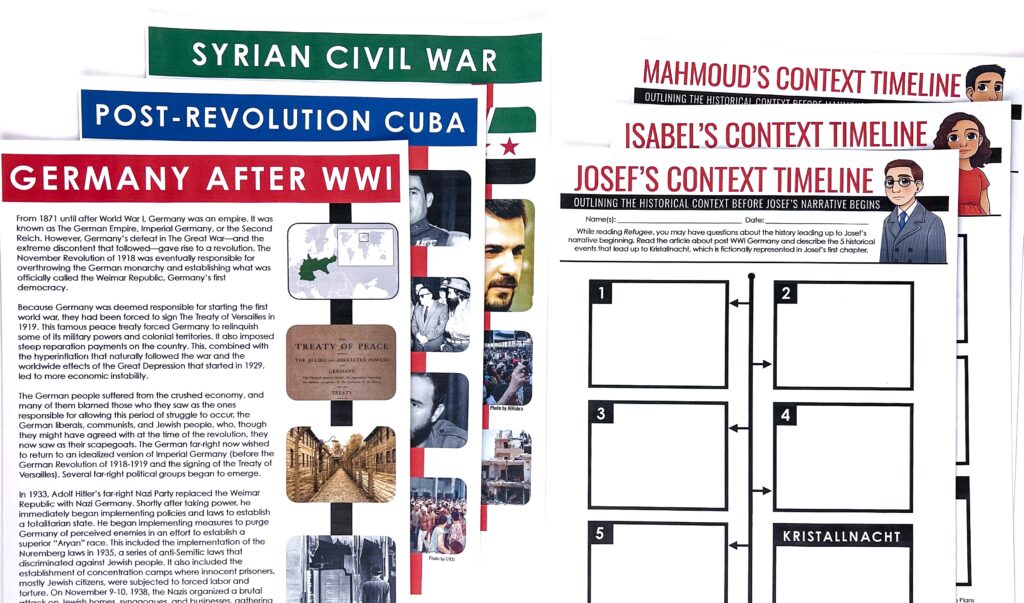
Real-World Connections
Many middle school teachers find their students are very moved by the plot of Refugee and often want to learn more about the human rights of refugees around the world. With this in mind, I like to spend some time looking at the United Nations’ Universal Declaration of Human Rights with students. First, students learn about the 30 universal human rights outlined in the document. Then, they can apply their learning as they analyze the various human rights violations in Refugee.
In this powerful learning task, students must consider each of the three protagonists’ experiences. You can choose to have students complete this task independently, or working in groups of three (with each group member taking on the perspective of one character). Once they identify the various ways in which human rights have been violated, students compose a paragraph that describes the violations each character experiences in the novel.

Looking for more tips for teaching Refugee? Check out my post on 12 Creative Activities for Teaching Refugee by Alan Gratz.
2. The Giver by Lois Lowry
With its gripping dystopian narrative, dynamic characters, and complex themes, Lois Lowry’s The Giver is an ideal choice for a middle school novel study. In particular, I love the opportunities this book provides for students to hone their critical thinking skills. In the novel, Jonas, who is 11, lives in a society that has eliminated pain, war, poverty, and hatred. The citizens have no memories of the past, and Sameness is a quality valued above all others.
Only one individual holds all the memories of humans in the past: the Receiver of Memory. When Jonas turns 12, he is assigned to his adult job. He will become the next Receiver of Memory, and begin his training immediately.
Memory Transmission Activity
Help students incorporate critical and historical thinking skills as they participate in this engaging middle school novel study activity, available as a free download! For this task, students will imagine how it feels for Jonas to receive all different kinds of memories. These include happy memories, such as the first moon landing, as well as difficult experiences, such as homelessness.
From here, students can discuss and explore the value of keeping the world’s memories safe, and the important role The Giver plays in their society. Then, they shift into the role of The Giver himself. To wrap up the task, they will select a “memory” that they deem historically important to transmit to Jonas.
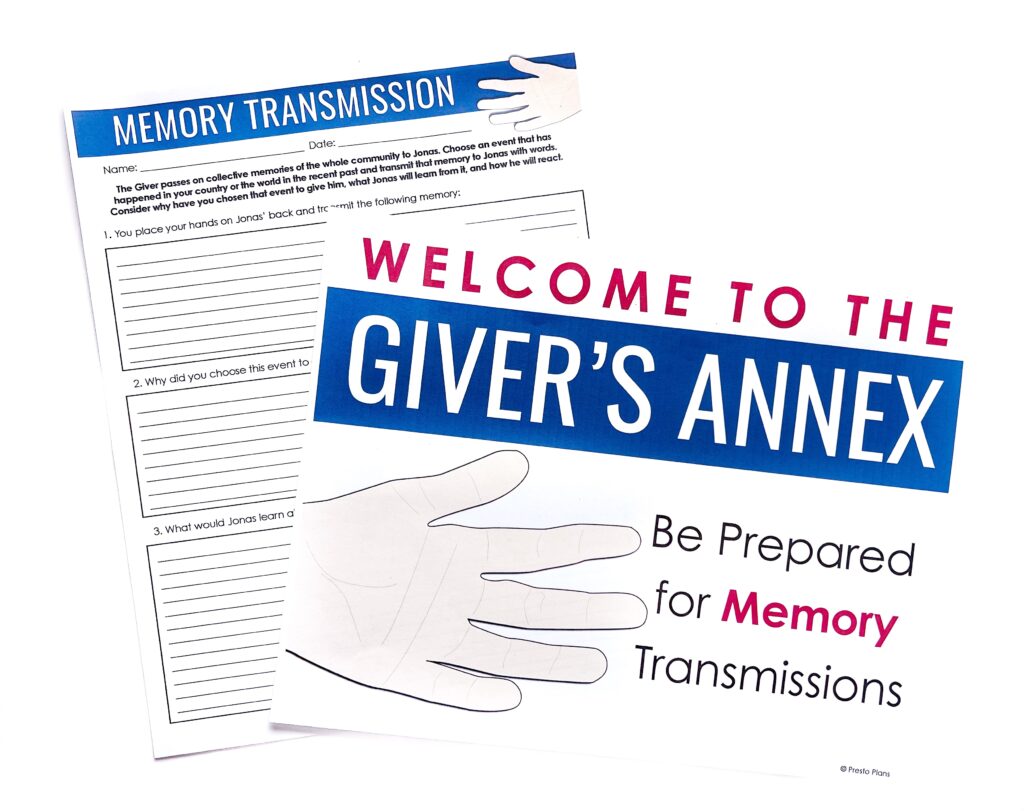
Family Forming Activity
In this task, students make real-world connections between the strict social structure seen in The Giver and aspects of some modern-day cultures. To begin, I like to start with a short pre-reading discussion, in which students consider how they would react if the government limited the amount of children they could have. Then I remind them that in The Giver, families are composed of a man, a woman, and two children, as mandated by the government.
From here, I share that until relatively recently in China, families there were only permitted to have one child in an attempt to control population growth. Students can then read an article or view a video on China’s one-child policy, recording their thoughts on a provided graphic organizer. Finally, to wrap up, I like to have them reflect on how this type of government policy connects to the world presented in The Giver.
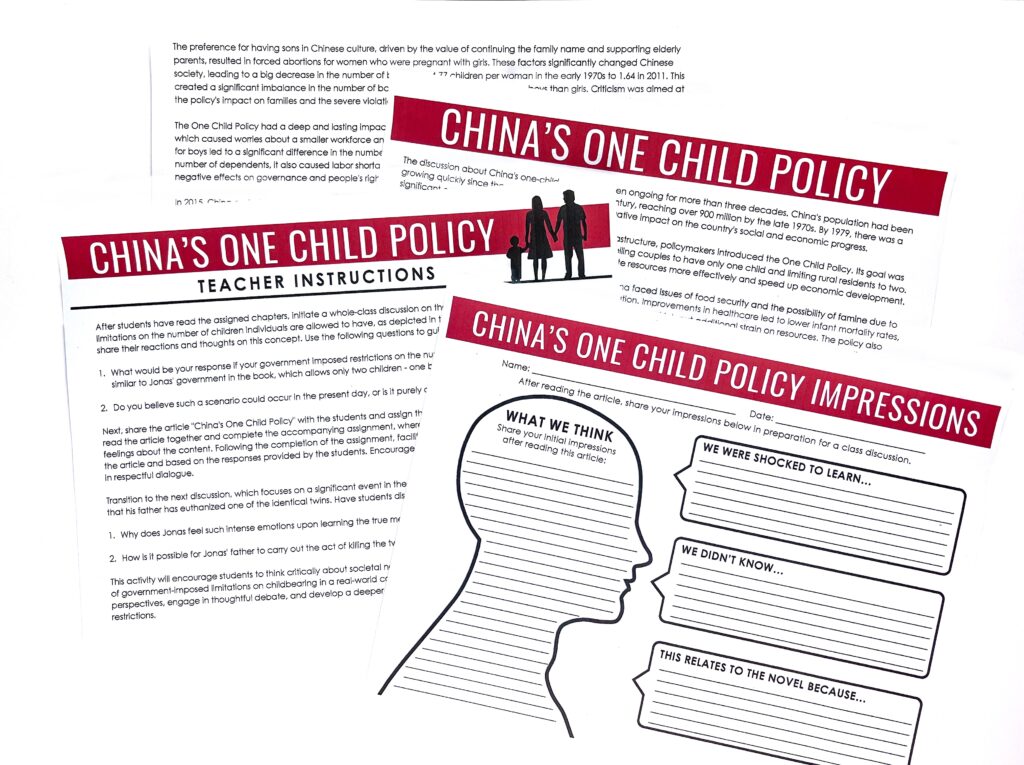
Looking for more engaging ideas for teaching The Giver in middle school ELA? Check out my post on The Giver: 8 Creative Class Activities.
3. The Outsiders by S.E. Hinton
S.E. Hinton’s classic coming-of-age novel is a popular middle school text for good reason. Originally published in 1967, the book centers around two gangs: the working-class “Greasers” (including the book’s narrator and protagonist, Ponyboy Curtis) and the upper-middle-class “Socs.”
I find the dramatic and emotional plotline of The Outsiders really resonates with students. Its powerful social commentary and exploration of Ponyboy’s struggles makes The Outsiders an ideal springboard to explore literary themes including childhood innocence, honor, self-sacrifice, and individual identity.
The Outsiders Identity Activity
I love to guide students through this activity as they read the first couple of chapters of The Outsiders. It challenges them to think about the concept of identity in general, how identity is represented in the novel, and the way they view their own identity. At the start of class, I explain that Ponyboy identifies as a greaser. Then, in small groups or as a whole class, I get students to discuss the important elements of identifying with this group (i.e. appearance, interests, actions, personality, etc.). Students should develop a list that may include such things as having long greased hair, fighting, committing crimes, being tough, carrying a switchblade, and showing loyalty, for example.
In the next step of the activity, students consider which identity “labels” (football player, dancer, musician, academic, etc.) might apply to them. To wrap up, I like to bring everyone back to a class discussion. Perhaps students didn’t feel like any labels applied to them, or they might have been challenged to narrow themselves to “fit” into only one identity!
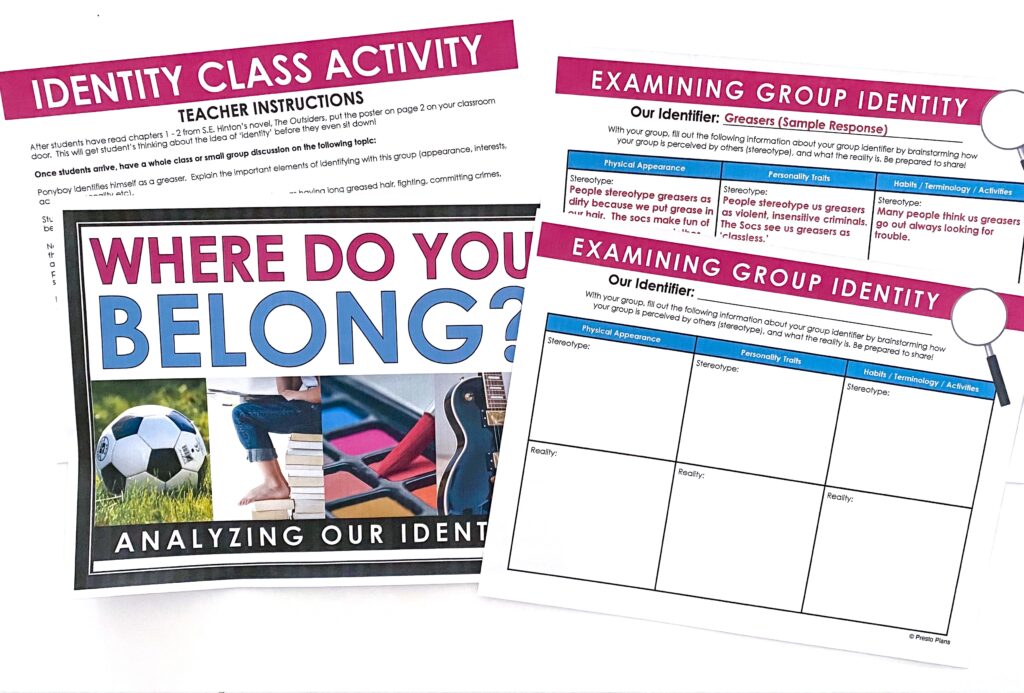
Nothing Gold Can Stay
Early in The Outsiders, Ponyboy recites Robert Frost’s “Nothing Gold Can Stay” – a poem which proves to be crucial later in the novel. Begin by handing each student a copy of “Nothing Gold Can Stay.” I usually like to project a video of Ponyboy reciting the poem (from The Outsiders film) as students follow along. I then review the poem, line by line, inviting students to dig deeper into the poem’s meaning. Students record their responses on a brainstorming sheet.
To conclude, I remind the students of the idea of impermanence – that all things in life eventually change. If time allows, students might like to complete a brief written reflection on how they will cope with inevitable changes that will arise in their lives.
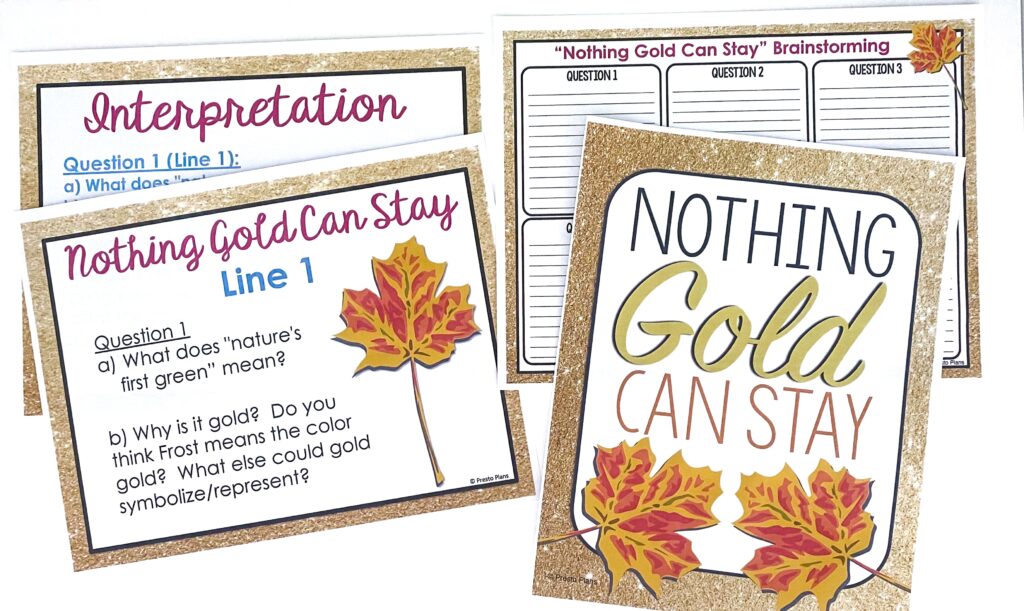
Looking for more ideas to bring The Outsiders to life in middle school ELA? Check out my post on 7 Creative Activities to Teach The Outsiders by S. E. Hinton.
4. Wonder by R.J. Palacio
Wonder by R.J. Palacio is a beloved middle school novel study selection (with good reason!). This moving and well-rounded story focuses on 10-year-old August “Auggie” Pullman, who has a genetic condition (Treacher Collins syndrome) that has left his face disfigured. Due to his medical needs, Auggie was homeschooled by his mother for several years. However, for the beginning of fifth grade, his parents enroll him in Beecher Prep, a private school
I love teaching Wonder for so many reasons, including its exploration of themes like empathy, compassion, acceptance, and anti-bullying. It gives students a chance to see the world through Auggie’s eyes and gain a greater understanding of his experiences.
WONDERful Acts of Kindness
At Beecher Prep, Auggie experiences true friendship and kindness from Summer, who eats lunch with him every day. Summer’s kind actions are the inspiration for the WONDERful Acts of Kindness Task!
First, students brainstorm various random acts of kindness they could perform at school, at home, or in their wider community. From here, I like to turn this task into a challenge! I ask each student to perform three random acts of kindness and pass along a “WONDERful Act of Kindness” card to the recipient, urging them to pay the action forward!
To wrap up, I like to encourage students to reflect on how others received their kind actions. This can be done through a brief piece of writing, in which they can also share their own feelings about performing random acts of kindness.
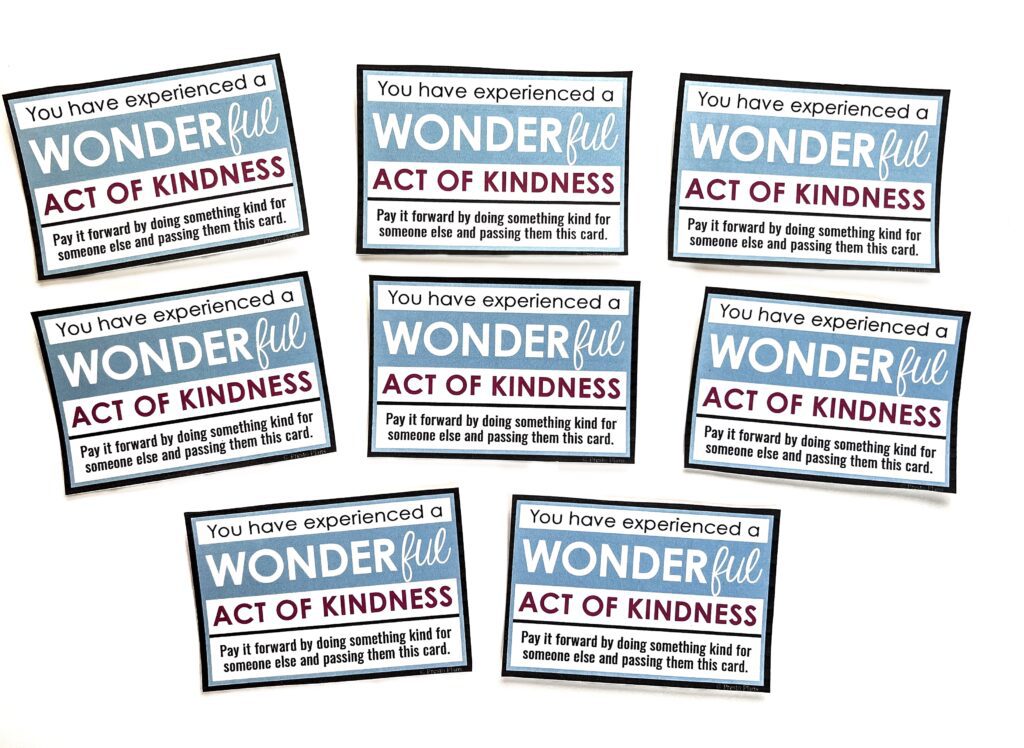
Wonder Lyrical Connections
I love finding opportunities to incorporate music into middle school ELA, including novel study units! I find that popular songs can help students make sense of their own complex feelings, and articulate them more clearly. In this task, I begin by breaking students into groups of five. Then, I have them listen to a selection of contemporary songs. Students often enjoy watching the music videos while reading the provided lyrics! Then, using a graphic organizer, students must select one lyric from each song, and explain how it relates to one of the themes in Wonder.
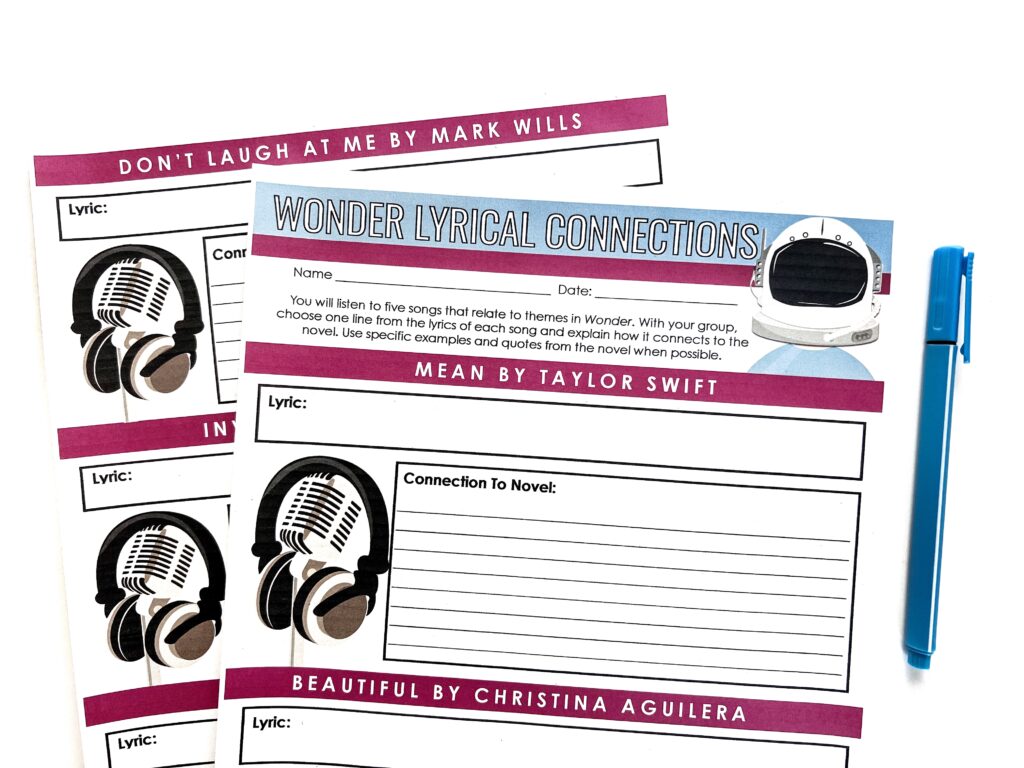
Interested in more tips for teaching Wonder as a middle school novel study? Check out my post on Teaching Wonder by R.J. Palacio: 8 Creative Activities.
5. Percy Jackson & The Olympians: The Lightning Thief
Percy Jackson & The Olympians: The Lightning Thief by Rick Riordan is a fantastic choice for a middle school novel study for so many reasons. In addition to being a masterclass in the mythology of Ancient Greece, this action-packed novel has well-rounded and relatable characters that really resonate with pre-teen and teenage readers.
The Lightning Thief is the first in a series of novels that bring Ancient Greek mythology into the 21st century. Percy Jackson, the protagonist, is a teenage demigod who, along with his friends, must prevent the Titans from destroying the world. I find that the book lends itself to a number of engaging and immersive activities that allow students to explore the dual worlds of Greek mythology and Percy’s modern-day life!
Virtual Field Trip
While Percy Jackson & The Olympians: The Lightning Thief helps to make Greek mythology accessible for middle school students, it does help to have some background knowledge. Unfortunately for most of us, a field trip to Greece isn’t in the budget, but that doesn’t mean that you can’t take your class on a virtual trip!
In this interactive task, students gain a stronger understanding of the various characters and myths referenced in the novel, right from the comfort of your classroom! Through their explorations of various art exhibits, they will learn more about Medusa, Athena, and Zeus, as well as various art forms.
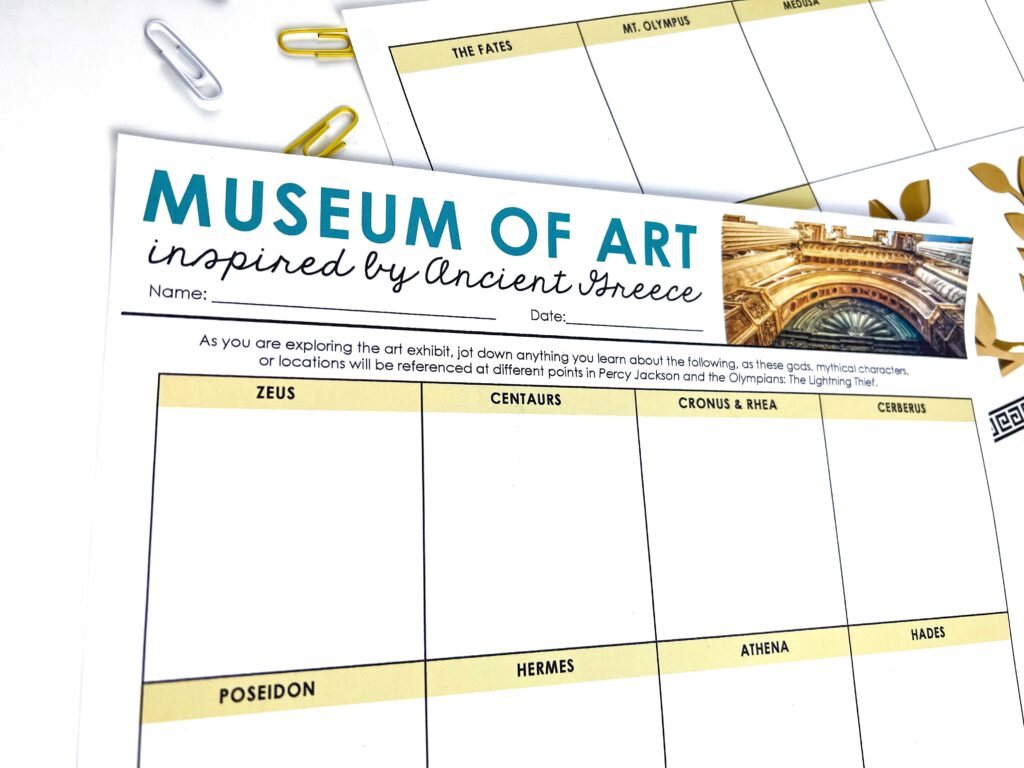
Similes of the Underworld
If you’re looking for a fresh twist on figurative language, why not have students apply their learning through a fun game! After briefly reviewing figurative language terms (especially similes), I split the class up into groups of four for a game of Similes of the Underworld.
Once students settle into their groups, I explain the rules. Each group needs to appoint one “judge” (you can rotate this position in each round so everyone has a chance to play). Then, I provide printable “fill in the blank” cards to each student (except for the judge). Meanwhile, the judge receives a “simile starter” card related to one of Percy’s experiences in the Underworld (for example, “The weight of my backpack felt like …”). Finally, each group member completes the sentence! Creativity – and even silliness – is encouraged! At the end of the round, the judge awards a point to the person who came up with the best (or funniest, or most creative) simile!
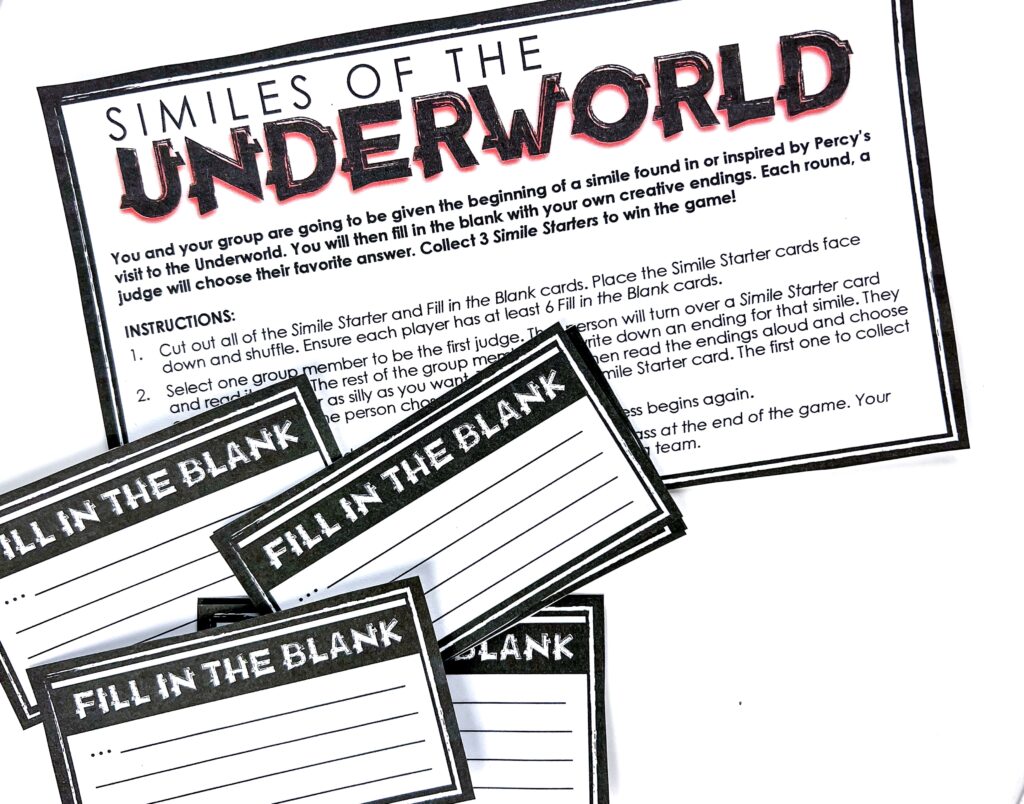
For more ideas to help you make the most of the Percy Jackson series, check out this post! 10 Creative Activities for Teaching Percy Jackson & The Olympians: The Lightning Thief by Rick Riordan.
I hope this post gives you lots of fresh ideas for your next middle school novel study!
Looking for even more creative ideas to support middle school readers? Check out my post on 50 Activities You Can Use With Any Novel Or Short Story!






Search the blog for what you are teaching
GIVEAWAYS
sent straight to your inbox!
share this post